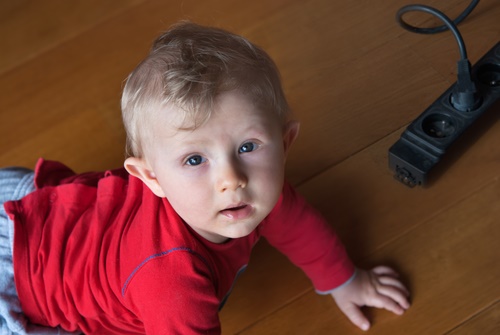Families have to start thinking about electrical safety before the day a child arrives in the home. In addition to protecting wall outlets from fingers and forks, your kids should be protected against electrical hazards — and educated about safety!
Keep what you can out of reach, and rely on routine electrical inspections to make sure wiring and outlets are in great condition.

Baby-proofing: Electrical Outlets and More
Here’s a quick rundown of baby-proofing a home against electrical hazards:
- Outlet covers: Options range from simple plastic inserts to tamper-proof electrical outlets that do not conduct a charge if an object is inserted into one slot, or require a sliding mechanism to open. The tamper-proof kinds are convenient because adults can easily use them but toddlers cannot accidentally shock themselves.
- Electrical cords: Don’t take chances with loose cords on the floor or extension cords all over the place! Raise wires up out of reach and get more outlets installed if you need more convenient plug-in spots.
- GFCI protection: Add GFCI to outlets or opt for a GFCI circuit to protect wet areas — especially if you might wash the baby in a sink or use your hair appliances in the bathroom with children nearby.
Kids and Teens: Teach and Protect
Protect kids of all ages with the baby-proofing tips above, plus:
- Regular electrical repairs: Take care of frayed or loose wires that are accessible in the attic, garage, and elsewhere. Replace loose wall outlets or light switch covers to help protect against shock and fire.
- Explain overloaded circuits: Teach your kids that wall outlets cannot be overloaded with power strips and extension cords. They should not have a TV, video game console, laptop, phone charger, and more devices all plugged into one outlet! Check on the outlets in their bedrooms and game rooms to make sure they follow the rules.
- Show them the circuit breaker panel: When your kids are tall enough to reach the service panel, you should teach them how it works. Then walk them through the steps of flipping a circuit breaker back on if one trips. You may want to lock the box until you’re sure they understand.
- Rule #1: Don’t touch! In terms they can understand, make sure all kids know that live wires and electrical parts can cause serious, lethal injury.
- Emergency response: Talk about what to do if someone gets electrocuted. The CDC has excellent advice for what to do if someone is electrocuted.
If you have a toddling youngster or a tween who has discovered the joy of tinkering with appliances, take time to explain to them why they should never try to investigate too deeply into the home’s electrical system. Better to buy them educational science toys from the store rather than let them tinker with old appliances.
Need help baby-proofing for electrical safety? Want to prevent house fires by adding more circuits or outlets to power your kids’ devices? Talk to us about electrical inspections and maintenance to keep your family safe!

